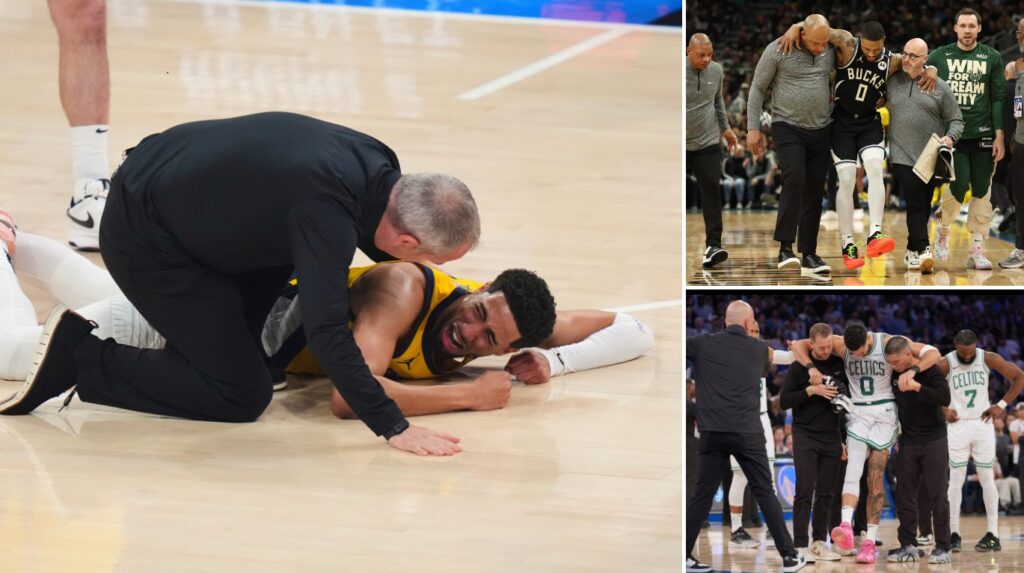The Shifting Landscape of NBA Stardom and Team Dynamics
A Tragic End to a Promising Playoff Run
As the NBA prepares to crown its latest champion, the postseason has also delivered its share of heartbreak. For Indiana Pacers guard Tyrese Haliburton, the culmination of his playoff journey was marred by a devastating injury. During a pivotal Game 7, his resilience and grit carried him to the brink of victory-only for him to suffer a torn Achilles’ tendon in the opening minutes of what could have been the defining game of his career. This injury not only halted his momentum but also underscored the brutal physical toll of postseason basketball.
The Evolving Role of Star Power in the NBA
This season’s playoffs have highlighted a significant shift in the importance and influence of individual stars. Unlike the era when a single superstar could carry a team deep into the postseason, today’s NBA emphasizes collective effort, strategic depth, and team cohesion. Haliburton’s injury exemplifies this change: a player who doesn’t rely on ego or ball dominance still finds himself vulnerable in the high-stakes environment. The narrative isn’t solely about the dominance of players like Shai Gilgeous-Alexander or the Oklahoma City Thunder; it’s also about how widespread misfortune, poor planning, and imbalanced rosters have made survival in the playoffs increasingly difficult for many.
The Toll of a Grueling Season on Elite Athletes
The past two months have been particularly unforgiving for NBA’s top-tier talent. High-profile injuries have sidelined stars such as LeBron James (knee sprain), Stephen Curry (hamstring), Ja Morant (hip bruise), and Aaron Gordon (hamstring). The toll extends beyond the playoffs, with regular-season casualties like Joel Embiid and Kyrie Irving illustrating the physical strain of an 82-game schedule. The relentless grind has prompted a reevaluation of player health management and team strategies, especially as teams grapple with salary cap restrictions that limit their ability to maintain top-tier rosters.
The New Powerhouse: Oklahoma City Thunder
Amidst this landscape, the Oklahoma City Thunder have emerged as a beacon of youthful excellence and strategic brilliance. Boasting the youngest championship-winning roster since the 1977 Portland Trail Blazers, the Thunder’s blend of seasoned talent and promising prospects has captivated fans and analysts alike. At the forefront is Shai Gilgeous-Alexander, who recently achieved a rare feat: winning the MVP, scoring title, and Finals MVP in a single season-a feat last accomplished by Shaquille O’Neal in 2000.
While Gilgeous-Alexander’s scoring prowess is undeniable, the team’s strength lies in its comprehensive approach. Their victory in Game 7 was not solely dependent on his 30-point averages but was driven by a cohesive defense, relentless energy, and strategic depth. The Thunder’s success is a testament to the meticulous planning of General Manager Sam Presti, who has built this roster through a combination of draft picks, shrewd trades, and selective free-agent signings.
Building a Resilient and Uncommon Team
Oklahoma City’s roster is a marvel of modern NBA construction. With 14 players under guaranteed contracts, most of whom were drafted or developed internally, the team exemplifies a sustainable model of success. Key contributors like Lu Dort, Isaiah Joe, and Chet Holmgren have been integrated through smart acquisitions, emphasizing skill, potential, and team chemistry. This approach contrasts sharply with the traditional star-centric model, favoring depth and resilience over reliance on a few marquee names.
Head Coach Mark Daigneault, at just 40 years old, has been instrumental in cultivating this culture of excellence. His leadership transformed the team from a rebuilding project into a championship contender within a few seasons. His philosophy emphasizes the importance of maintaining a high floor-ensuring consistent performance even against the league’s toughest opponents-rather than solely aiming for peak excellence.
The Future of NBA Team Building
The Thunder’s success underscores a broader trend in the NBA: the rise of balanced, well-constructed teams that prioritize depth, defense, and cohesion. This paradigm shift is evident in the recent Finals participants, where the highest-floor teams-those with the most reliable and versatile rosters-have prevailed. The era of assembling superteams through high-profile trades and free-agent splurges is giving way to a more sustainable, strategic approach.
In this context, the Indiana Pacers exemplify a different but equally effective philosophy. Led by Tyrese Haliburton’s selfless playmaking, they have built a roster that emphasizes versatility and grit. Despite his injury, Haliburton’s leadership and unselfish style allowed Indiana to compete at a high level, demonstrating that team success often hinges on collective effort rather than individual heroics.
Lessons from the Playoffs: Resilience and Adaptability
Haliburton’s post-game gesture-greeting teammates on crutches-embodies the spirit of resilience that now defines the NBA. His humility and dedication serve as a model for the league, emphasizing that greatness is not solely about individual talent but also about character and teamwork. As the league evolves, teams are increasingly recognizing that sustainable success depends on building resilient, adaptable rosters capable of weathering injuries and setbacks.
The Changing Face of Superstardom
The recent trade of Kevin Durant to Houston marks a pivotal moment in the league’s ongoing transformation. Once a symbol of the superteam era, Durant’s move reflects a broader shift toward more balanced and strategic team compositions. While Durant remains an elite scorer and playmaker, the league’s emphasis on collective strength and depth suggests that even the most talented players must adapt to a new paradigm-one where fitting into a cohesive unit is paramount.
Conclusion: Embracing a New Era of NBA Excellence
The 2024-25 NBA season has reaffirmed that the league is entering a new chapter-one characterized by strategic roster construction, resilience, and a focus on team cohesion. The Thunder’s rise, the resilience of players like Haliburton, and the evolving approach to building championship-caliber teams all point toward a future where sustainable success is rooted in depth, adaptability, and character. As the league continues to evolve, the old model of star dominance is giving way to a more balanced, competitive landscape-one that promises exciting developments for fans and players alike.

